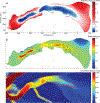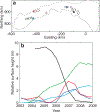Dynamics of active subglacial lakes in Recovery Ice Stream
- PMID: 32601580
- PMCID: PMC7323638
- DOI: 10.1002/2017JF004409
Dynamics of active subglacial lakes in Recovery Ice Stream
Abstract
Recovery Ice Stream has a substantial number of active subglacial lakes that are observed, with satellite altimetry, to grow and drain over multiple years. These lakes store and release water that could be important for controlling the velocity of the ice stream. We apply a subglacial hydrology model to analyze lake growth and drainage characteristics together with the simultaneous development of the ice stream hydrological network. Our outputs produce a good match between modeled lake location and those identified using satellite altimetry for many of the lakes. The modeled subglacial system demonstrates development of pressure waves that initiate at the ice stream neck and transit to within 100 km of the terminus. These waves alter the hydraulic potential of the ice stream and encourage growth and drainage of the subglacial lakes. Lake drainage can cause large R-channels to develop between basal overdeepenings that persist for multiple years. The pressure waves, along with lake growth and drainage rates, do not identically repeat over multiple years, due to basal network development. This suggests that the subglacial hydrology of Recovery Ice Stream is influenced by regional drainage development on the scale of hundreds of kilometers rather than local conditions over tens of kilometers.
Figures





References
-
- Banwell A, Hewitt I, Willis I, and Arnold N. (2016), Moulin density controls drainage development beneath the Greenland Ice Sheet, Journal of Geophysical Research: Earth Surface, 121 (12), 2248–2269.
-
- Bartholomew I, Nienow P, Sole A, Mair D, Cowton T, and King MA (2012), Short-term variability in Greenland Ice Sheet motion forced by time-varying meltwater drainage: Implications for the relationship between subglacial drainage system behavior and ice velocity, Journal of Geophysical Research, 117 (F3), F03,002.
-
- Bell RE, Studinger M, Shuman CA, Fahnestock MA, and Joughin I. (2007), Large subglacial lakes in East Antarctica at the onset of fast-flowing ice streams, Nature, 445 (7130), 904–907. - PubMed
-
- Borsa AA, Moholdt G, Fricker HA, and Brunt KM (2014), A range correction for ICESat and its potential impact on ice-sheet mass balance studies, The Cryosphere, 8 (2), 345–357, doi:10.5194/tc-8-345-2014. - DOI
-
- Carter S, and Fricker H. (2012), The supply of subglacial meltwater to the grounding line of the Siple Coast, West Antarctica, Annals of Glaciology, 53 (60), 267–280.
